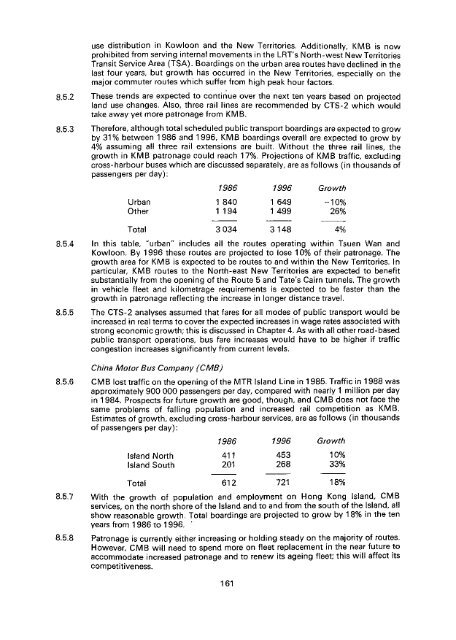Untitled - HKU Libraries - The University of Hong Kong
Untitled - HKU Libraries - The University of Hong Kong
Untitled - HKU Libraries - The University of Hong Kong
- No tags were found...
You also want an ePaper? Increase the reach of your titles
YUMPU automatically turns print PDFs into web optimized ePapers that Google loves.
use distribution in Kowloon and the New Territories. Additionally, KMB is nowprohibited from serving internal movements in the LRT's North-west New TerritoriesTransit Service Area (ISA). Boardings on the urban area routes have declined in thelast four years, but growth has occurred in the New Territories, especially on themajor commuter routes which suffer from high peak hour factors.8.5.2 <strong>The</strong>se trends are expected to continue over the next ten years based on projectedland use changes. Also, three rail lines are recommended by CTS-2 which wouldtake away yet more patronage from KMB.8.5.3 <strong>The</strong>refore, although total scheduled public transport boardings are expected to growby 31% between 1986 and 1996, KMB boardings overall are expected to grow by4% assuming all three rail extensions are built. Without the three rail lines, thegrowth in KMB patronage could reach 17%. Projections <strong>of</strong> KMB traffic, excludingcross-harbour buses which are discussed separately, are as follows (in thousands <strong>of</strong>passengers per day):1986 1996 GrowthUrban 1 840 1 649 -10%Other 1 194 1 499 26%Total 3034 3148 4%8.5.4 In this table, "urban" includes all the routes operating within Tsuen Wan andKowloon. By 1996 these routes are projected to lose 10% <strong>of</strong> their patronage. <strong>The</strong>growth area for KMB is expected to be routes to and within the New Territories. Inparticular, KMB routes to the North-east New Territories are expected to benefitsubstantially from the opening <strong>of</strong> the Route 5 and Tate's Cairn tunnels. <strong>The</strong> growthin vehicle fleet and kilometrage requirements is expected to be faster than thegrowth in patronage reflecting the increase in longer distance travel.8.5.5 <strong>The</strong> CTS-2 analyses assumed that fares for all modes <strong>of</strong> public transport would beincreased in real terms to cover the expected increases in wage rates associated withstrong economic growth; this is discussed in Chapter 4. As with all other road-basedpublic transport operations, bus fare increases would have to be higher if trafficcongestion increases significantly from current levels.China Motor Bus Company (CMB)8.5.6 CMB lost traffic on the opening <strong>of</strong> the MTR Island Line in 1985. Traffic in 1988 wasapproximately 900 000 passengers per day, compared with nearly 1 million per dayin 1984. Prospects for future growth are good, though, and CMB does not face thesame problems <strong>of</strong> falling population and increased rail competition as KMB.Estimates <strong>of</strong> growth, excluding cross-harbour services, are as follows (in thousands<strong>of</strong> passengers per day):1986 1996 GrowthIsland North 411 453 10%Island South 201 268 33%Total 612 721 18%8.5.7 With the growth <strong>of</strong> population and employment on <strong>Hong</strong> <strong>Kong</strong> Island, CMBservices, on the north shore <strong>of</strong> the Island and to and from the south <strong>of</strong> the Island, allshow reasonable growth. Total boardings are projected to grow by 18% in the tenyears from 1986 to 1996. *8.5.8 Patronage is currently either increasing or holding steady on the majority <strong>of</strong> routes.However, CMB will need to spend more on fleet replacement in the near future toaccommodate increased patronage and to renew its ageing fleet; this will affect itscompetitiveness.161
















